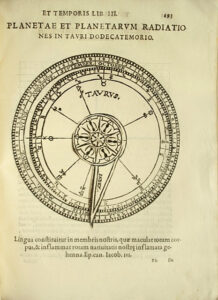Venice, Giovanni Battita Somasco, 1588.
4to [243 x 184 mm.] of (8) ll., 478 pp., (1) l. of errata, more than 140 engraved figures in the text, of which 50 have a total of 70 volvelles. P. 229 has been bound twice. Some waterstaining. Bound in full contemporary limp vellum, remains of ties, flat spine with handwritten title, handwritten title on the bottom edge. Contemporary binding.
Rare and very precious first edition of the first celestial atlas, “giving the coordinates of the stars and the first atlas to use the coordinates of Copernicus.”
Adams G168; Mortimer, Italian, 206; Riccardi I: 568.
Published in Venice in 1588, the Theatrum mundi presents the 48 maps of the classical Greek constellations, each preceded with a catalog of the stars which compose them with their coordinates and sizes, and shows a magnificent collection of mythological figures. The positions of the stars are taken from the Copernicus’ catalog.
“Gallucci’s work is remarkable because it is the first atlas using a system of coordinates from which the latitude and longitude of the stars could be read from the margins. The very popular ‘Theatrum Mundi’ was printed again several times after the edition of 1588”. (Star maps… Nick Kanas).
This book is considered as the first modern celestial atlas because in the maps, Gallucci uses a system of coordinates and a trapezoidal projection system in order to determine the actual positions of the stars.
« Gallucci’s works are known for their visual impact ».
“There are 48 woodcut maps of the Ptolemaic constellations, each of which is preceded by a catalogue of the included stars identifying position within the constellation, latitude and longitude (in degrees and minutes), magnitude, and nature… The longitudes on Gallucci’s catalog and on his map are those published by Copernicus in ‘De Revolutionibus’ (1543). (Warner). The constellation figures are extremely lively and original here.”
“The ‘Theatrum mundi’ was extremely popular, and was published again in 1589 and 1603 and the Spanish translation of 1606 appeared in three subsequent editions”.
The volume is decorated with the printer’s mark on the title, 144 full-page woodcuts, of which 50 have a total of 70 volvelles.
The volume is also decorated with head and tail-pieces and wood engraved initials.
Jean-Paul Gallucci, Italian astronomer from the 16th century, was born in Salo in 1538.
He was a member of the Academy of Venice. After studying in Salo, and then in Padua, he went to the Venice. His interests ranged from astronomy and physics to medicine and literature. He had invented an instrument he used to observe easily phenomena from the sky round the clock.
A magnificent copy preserved in its contemporary limp vellum, complete with the rare constellation of Cepheus, not including in pagination, between ll. Mm4 and Nn1.
Provenance: hand-written ex libris on the title, engraved ex libris pasted on the back of the title “Mutio Sforza da Cotignola”.

![Theatrum mundi, et temporis, In quo non solum precipuae horum partes describuntur… sed accomodatissimis figuris sub oculos legentium facile ponontur […].](https://www.camillesourget.com/wp-content/uploads/2023/03/gallucci-pl2-s0iGb.jpg)
![Theatrum mundi, et temporis, In quo non solum precipuae horum partes describuntur… sed accomodatissimis figuris sub oculos legentium facile ponontur […]. - Image 2](https://www.camillesourget.com/wp-content/uploads/2023/03/gallucci-pl2-YId1k.jpg)
![Theatrum mundi, et temporis, In quo non solum precipuae horum partes describuntur… sed accomodatissimis figuris sub oculos legentium facile ponontur […]. - Image 3](https://www.camillesourget.com/wp-content/uploads/2023/03/gallucci-pl1-QDxnL.jpg)
![Theatrum mundi, et temporis, In quo non solum precipuae horum partes describuntur… sed accomodatissimis figuris sub oculos legentium facile ponontur […]. - Image 4](https://www.camillesourget.com/wp-content/uploads/2023/03/gallucci-rel-0ZHh5.jpg)
![Theatrum mundi, et temporis, In quo non solum precipuae horum partes describuntur… sed accomodatissimis figuris sub oculos legentium facile ponontur […]. - Image 5](https://www.camillesourget.com/wp-content/uploads/2023/03/gallucci-titre-MNAsa.jpg)
